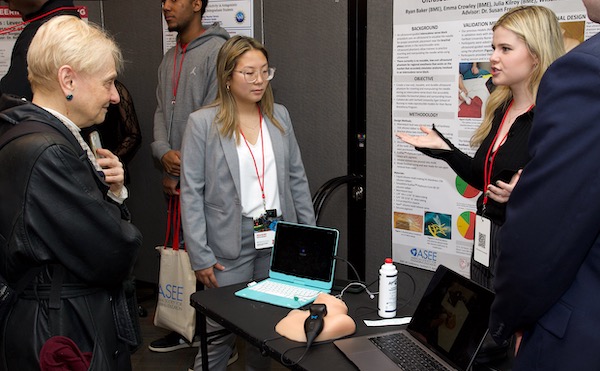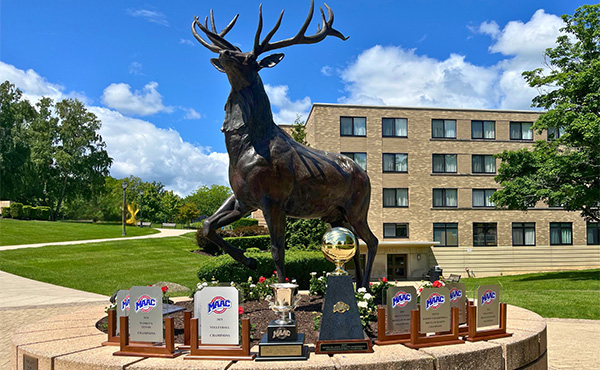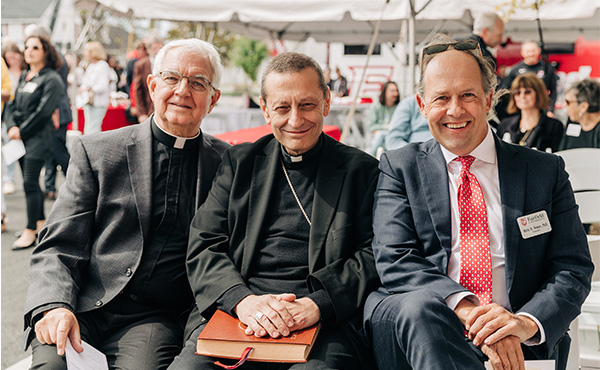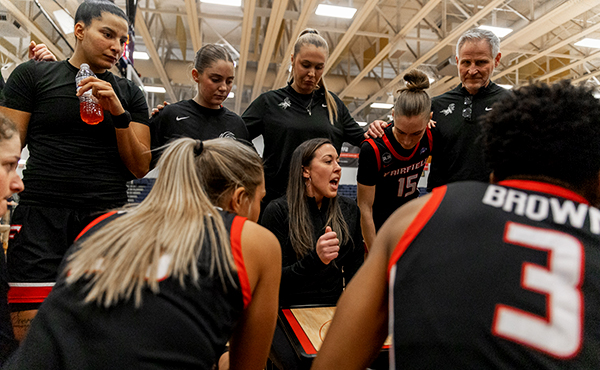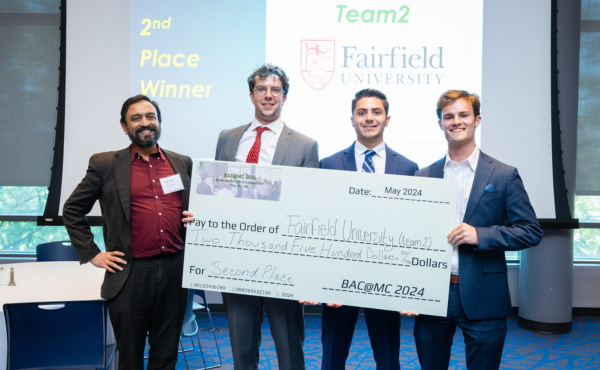In a groundbreaking collaboration between Fairfield University's School of Engineering and Computing and Egan School of Nursing and Health Studies, two pioneering research projects have emerged, promising to revolutionize medical training and patient care.
Improvements to a Life-saving Training Device
One of the crucial skills for medical professionals, especially those in emergency medicine, anesthesiology, and nurse anesthesia, is the emergency cricothyrotomy. This life-saving procedure allows professionals to provide oxygen to patients with obstructed airways. However, the commercially available manikins needed to learn and practice the procedure are expensive ($1000-$2000 each), limiting access for proper skill building. A group of innovative Fairfield biomedical engineering students and faculty mentor, Dr. Susan Freudzon, partnered with students in the Egan School to identify the need for an affordable cricothyrotomy training system and craft a solution. The Fairfield University Hardiman Scholars Fund and INSPIRE Research Fund helped support their research.
Initial models included a 3D-printed trachea with artificial skin they molded from silicone that nurse anesthesia students used to practice the procedure. “It was exciting for the engineering students to see their work being used by the nursing students,” said Freudzon. Direct feedback from the nurses-in-training gave the Biomedical Engineering Society students ideas for how to improve the device. So, the team, led by Emma Crowley ’24, Ryan Jaworski ’25, Matthew Manduca ’25, and Maeve O'Connell ’25, went back to the drawing board to revise and test new iterations.
The first challenge was stabilizing the model on a smaller and better base and improving the artificial skin to make it more realistic. Through trial and error, they created a 3D printed base in the shape of a neck using Solidworks software and secured the trachea to the base with Velcro—an improvement over the wooden plank and nails used in previous models. They also discovered that the material tattoo artists use to practice their art was the best alternative to real skin. At under $100 to produce the entire device, the students’ innovation is primed to change how nursing students learn to perform cricothyrotomies—a crucial skill for emergency scenarios. The team presented their customizable, cost-effective solution at the Fairfield Innovative Research Symposium and the American Society for Engineering Education Conference. They plan to publish their design as an open-source resource so other nurse training institutions can benefit from this healthcare innovation.
The students will continue to collaborate by using the models for training and improving their designs even more next year. Based on further feedback, the team will design and test models with different skin thicknesses to mimic patients with more fat. “It’s really important for bioengineering students to have experience trying out new ideas, testing them, getting feedback, and thinking outside of the box to try something different,” said Maeve O’Connell. “Plus, it’s super fun to work on projects like these.” O’Connell plans to put the experience to good use doing research with a Fairfield professor over the summer. Her long-term goal is to pursue a biotech graduate degree and discover life-saving drugs, including a cure for ALS.
Building Better Training Models for Ultrasound-guided Anesthesia
A second project aims to improve regional anesthesia training, specifically targeting the brachial plexus ultrasound phantom. In biomedical research and training, phantoms are objects used as stand-ins for human tissues, providing a realistic and safe environment for healthcare professionals to hone their skills. The lack of a reusable, low-cost ultrasound phantom for regional anesthesia made training to administer an interscalene nerve block in the brachial plexus area difficult and expensive. Led by the same collaborative spirit that propelled the affordable cricothyrotomy training device project, a team of Fairfield University biomedical engineering students, including Emma Crowley ’24, Julia Kilroy ’24, Ryan Baker’24, and Wilson Kaznoski ’24, worked with the Egan School of Nursing to address the limitations of existing solutions in ultrasound phantoms for regional anesthesia—high cost, poor durability, and anatomical inaccuracy. Thanks to support from the Fairfield University INSPIRE Research Fund, the group worked on the problem all year for their senior design project.
Crowley said her favorite part of the project was the interdisciplinary work with the nursing school. “I’m a biomedical engineering major, but I’m also pre-PA, so being able to meet with the nursing students and professors to learn how the procedure is done and to get feedback was helpful,” she said. “My anatomy class also helped me understand how to improve the design of the mold and what it needed to look like on the ultrasound.” Because the School of Engineering and the Egan School of Nursing are right next to each other, collaboration was as easy as traversing the walkway that connects the two disciplines. The students conferred with each other and their professors in real-time throughout the year to guide their designs.
One of the main challenges was figuring out the type of silicone to use to imitate human skin. Too stiff and the training nurses couldn’t move the needle around. Too soft, and the repetitive pokes from the needle would create tracks that students could follow rather than finding the target nerves on their own. The materials also impacted how well students could visualize the needle on the ultrasound to find their target. Plenty of things went wrong in the process—the silicone didn’t always cure properly or stuck to the mold if it wasn’t sprayed with enough lubricant. Their 3-D printed models of the nerve network didn’t show up well on the ultrasound. Through lots of trial and error, the team created a custom silicone mold and crafted brachial plexus nerves and arteries out of latex tubing to produce a realistic model of the neck and shoulder area. Their innovative phantom allows for ultrasound-guided needle insertion and manipulation, offering trainees a true-to-life experience. The model even has a 3-D printed collar bone that the expensive commercially available models do not. Future design iterations will incorporate feedback from the nursing students who use the prototype during the summer regional anesthesia class.
“From a faculty perspective, it was rewarding to see the students’ learning evolve as they went through the design process,” said Freudzon. They presented the project at the Northeast Bioengineering Conference and the ASEE Conference, where they won the award for the best poster. The engineering school’s dean also gave them the award for the best senior design project. They plan to publish the detailed instructions and downloadable files for future use and will submit the research to a medical device design journal or nurse anesthesia journal for possible publication.
By prioritizing low-cost materials, anatomical accuracy, and ease of use, Fairfield's engineering and nursing teams have developed two solutions that not only enhance training but also improve patient outcomes. Their commitment to making their projects open source ensures that institutions worldwide can benefit from this groundbreaking innovation. The Biomedical Engineering Society club will pick up the next steps for both projects, helping Fairfield University lead the way in interdisciplinary collaboration and impactful research.
Learn more about the School of Engineering and Computing at fairfield.edu/engineering.
